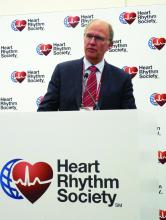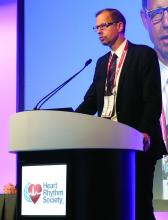BOSTON – From the earliest days of using catheter ablation to treat atrial fibrillation (AF), in the 1990s, clinicians have defined ablation success based on whether patients had recurrence of their arrhythmia following treatment. New findings suggest that this standard was off, and that
The new study used data collected in the CASTLE-AF (Catheter Ablation vs. Standard Conventional Treatment in Patients With LV Dysfunction and AF) multicenter trial, which compared the efficacy of AF ablation with antiarrhythmic drug treatment in patients with heart failure for improving survival and freedom from hospitalization for heart failure. The trial’s primary finding showed that, in 363 randomized patients, AF ablation cut the primary adverse event rate by 38% relative to antiarrhythmic drug therapy (New Engl J Med. 2018 Feb 1;378[5]:417-27)
Post hoc analysis of the CASTLE-AF results has shown that patients whose AF burden was reduced to less than 6% after ablation experienced a 2.5- to 3.3-fold increased rate of freedom from adverse outcomes, compared with patients with posttreatment AF burdens of 6% or greater when investigators followed them for a year, Johannes Brachmann, MD, reported at the annual scientific sessions of the Heart Rhythm Society. In contrast, the incidence of AF recurrence following ablation had no statistically significant relationship with freedom from death or hospitalization for heart failure, and the effects of antiarrhythmic drug treatment on both AF burden and AF recurrence had no significant relationship with CASTLE-AF’s primary outcome, said Dr. Brachmann, professor and chief of cardiology at the Coburg (Germany) Clinic.“There have been concerns about the high recurrence rate of AF following ablation,” with reported cumulative recurrence rates running as high as 80% by 5 years after ablation, noted Dr. Brachmann. “The news now is that recurrence alone doesn’t make a difference; we can still help patients” by reducing their AF burden, although he cautioned that this relationship has so far only been seen in patients with heart failure with reduced ejection fraction, the type of patients enrolled in CASTLE-AF.
“This information is very informative for clinicians counseling patients who undergo ablation. Ablation may not eliminate all of a patient’s AF, but it will substantially reduce it, and that’s associated with better outcomes,” commented Andrew D. Krahn, MD, professor and chief of cardiology at the University of British Columbia in Vancouver. “Early on using ablation, we had a curative approach and used ablation to ‘clip the wire.’ Now we have growing, objective evidence for ‘debulking’ the problem” working without the need to completely eliminate all AF episodes.
The CASTLE-AF data “give tantalizing information into the question of whether you need to reduce AF or totally stop it to have a benefit in patients with heart failure,” commented Mark S. Link, MD, professor and director of cardiac electrophysiology at the University of Texas Southwestern Medical Center in Dallas. “There is plenty of evidence that antiarrhythmic drugs are of little benefit for HFrEF [heart failure with reduced ejection fraction] patients with AF. It’s a real stretch of these new findings to say these patients need to first fail treatment with at least one antiarrhythmic drug before they should be offered ablation.”To run the post hoc analysis Dr. Brachmann and his associates categorized the 363 patients randomized in CASTLE-AF by the treatment they received during the study’s first 12 weeks: 150 patients underwent catheter ablation, and 210 received drug treatment, with three patients dropping out. Although this division of the patients diverged from the randomized subgroups, the ablated and drug-treated patients showed no significant differences when compared for several clinical parameters.



